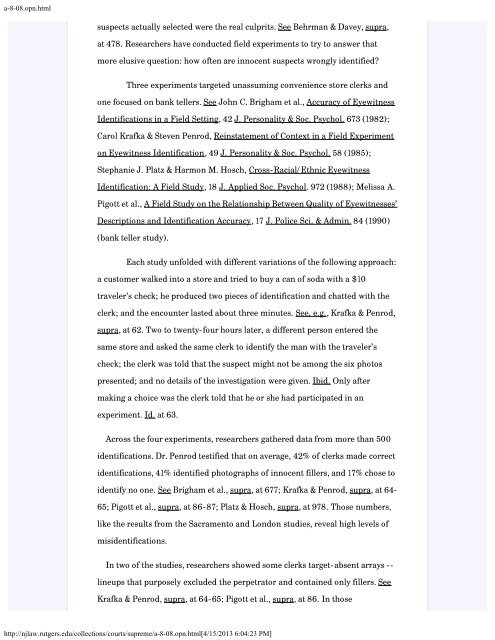State v. Henderson and the New Model Jury Charges - New Jersey ...
State v. Henderson and the New Model Jury Charges - New Jersey ...
State v. Henderson and the New Model Jury Charges - New Jersey ...
You also want an ePaper? Increase the reach of your titles
YUMPU automatically turns print PDFs into web optimized ePapers that Google loves.
a-8-08.opn.html<br />
suspects actually selected were <strong>the</strong> real culprits. See Behrman & Davey, supra,<br />
at 478. Researchers have conducted field experiments to try to answer that<br />
more elusive question: how often are innocent suspects wrongly identified?<br />
Three experiments targeted unassuming convenience store clerks <strong>and</strong><br />
one focused on bank tellers. See John C. Brigham et al., Accuracy of Eyewitness<br />
Identifications in a Field Setting, 42 J. Personality & Soc. Psychol. 673 (1982);<br />
Carol Krafka & Steven Penrod, Reinstatement of Context in a Field Experiment<br />
on Eyewitness Identification, 49 J. Personality & Soc. Psychol. 58 (1985);<br />
Stephanie J. Platz & Harmon M. Hosch, Cross-Racial/Ethnic Eyewitness<br />
Identification: A Field Study, 18 J. Applied Soc. Psychol. 972 (1988); Melissa A.<br />
Pigott et al., A Field Study on <strong>the</strong> Relationship Between Quality of Eyewitnesses’<br />
Descriptions <strong>and</strong> Identification Accuracy, 17 J. Police Sci. & Admin. 84 (1990)<br />
(bank teller study).<br />
Each study unfolded with different variations of <strong>the</strong> following approach:<br />
a customer walked into a store <strong>and</strong> tried to buy a can of soda with a $10<br />
traveler’s check; he produced two pieces of identification <strong>and</strong> chatted with <strong>the</strong><br />
clerk; <strong>and</strong> <strong>the</strong> encounter lasted about three minutes. See, e.g., Krafka & Penrod,<br />
supra, at 62. Two to twenty-four hours later, a different person entered <strong>the</strong><br />
same store <strong>and</strong> asked <strong>the</strong> same clerk to identify <strong>the</strong> man with <strong>the</strong> traveler’s<br />
check; <strong>the</strong> clerk was told that <strong>the</strong> suspect might not be among <strong>the</strong> six photos<br />
presented; <strong>and</strong> no details of <strong>the</strong> investigation were given. Ibid. Only after<br />
making a choice was <strong>the</strong> clerk told that he or she had participated in an<br />
experiment. Id. at 63.<br />
Across <strong>the</strong> four experiments, researchers ga<strong>the</strong>red data from more than 500<br />
identifications. Dr. Penrod testified that on average, 42% of clerks made correct<br />
identifications, 41% identified photographs of innocent fillers, <strong>and</strong> 17% chose to<br />
identify no one. See Brigham et al., supra, at 677; Krafka & Penrod, supra, at 64-<br />
65; Pigott et al., supra, at 86-87; Platz & Hosch, supra, at 978. Those numbers,<br />
like <strong>the</strong> results from <strong>the</strong> Sacramento <strong>and</strong> London studies, reveal high levels of<br />
misidentifications.<br />
In two of <strong>the</strong> studies, researchers showed some clerks target-absent arrays --<br />
lineups that purposely excluded <strong>the</strong> perpetrator <strong>and</strong> contained only fillers. See<br />
Krafka & Penrod, supra, at 64-65; Pigott et al., supra, at 86. In those<br />
http://njlaw.rutgers.edu/collections/courts/supreme/a-8-08.opn.html[4/15/2013 6:04:23 PM]
















